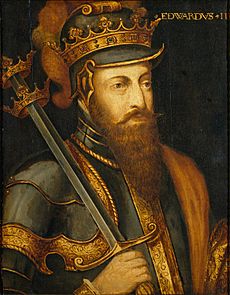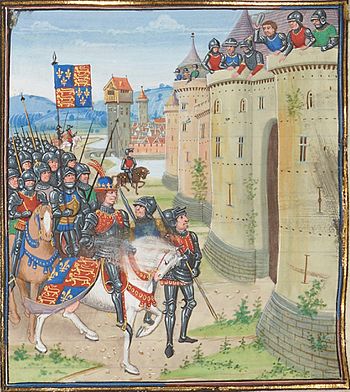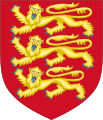Burnt Candlemas facts for kids
Quick facts for kids Burnt CandlemasEnglish invasion of Scotland (1356) |
|||||||
|---|---|---|---|---|---|---|---|
| Part of the Second War of Scottish Independence | |||||||
|
|||||||
| Belligerents | |||||||
| Commanders and leaders | |||||||
| King Edward III | William, Lord Douglas | ||||||
Burnt Candlemas was a failed invasion of Scotland by King Edward III in early 1356. This event was the last major campaign of the Second War of Scottish Independence. It got its name because the English army burned so much of the Scottish region of Lothian around February 2. This date was known as Candlemas, a time when people blessed their candles for the year.
In 1355, tensions grew between England and Scotland. Both sides gathered their armies. A nine-month truce was agreed upon in September. Most English soldiers then left for France to fight in the Hundred Years' War. However, the Scots, encouraged by France, broke the truce just a few days later. They invaded and damaged Northumberland in northern England. In late December, the Scots attacked and captured the important English-held town of Berwick-on-Tweed. They also began to attack its castle. The English army quickly returned from France to Newcastle in northern England.
The English army marched to Berwick and took the town back. By mid-January 1356, they moved to Roxburgh in southern Scotland. From there, they marched towards Edinburgh, burning and destroying everything in a wide path. The Scots used a "scorched earth" tactic. This meant they avoided battles and removed or destroyed all food in their own territory. The English reached and burned Edinburgh. Their supplies arrived by sea at Haddington. King Edward III planned to march on Perth. But strong winds stopped his supply ships from moving. While waiting for better winds, the English completely destroyed Lothian. This is why the event became known as "Burnt Candlemas."
A winter storm then scattered the English fleet, forcing the English to retreat. They marched back through Melrose, still destroying Scottish land. But this time, Scottish forces attacked them along the way. The English army was sent home from Carlisle in late February. After they left, the Scots captured two more English-held castles. A new truce was made in April. In 1357, a lasting peace was agreed upon, mostly on England's terms.
Contents
The Wars for Scottish Independence
The First War of Scottish Independence began in 1296. This was when Edward I of England attacked and captured the Scottish border town of Berwick-upon-Tweed. Berwick was very important for trade and military control in the border area. Over 32 years of fighting followed. Berwick was taken back by the Scots in 1318.
In 1327, a battle called the Weardale campaign went very badly for the English. This made the English leaders, Isabella of France and Roger Mortimer, agree to talk peace. They signed the Treaty of Northampton with Robert Bruce in 1328. This treaty officially recognized Scotland as an independent country.
King Edward III, who was young at the time, never truly accepted this treaty. In 1332, he supported Edward Balliol, who claimed to be the rightful king of Scotland. By 1333, England and Scotland were at war again. This started the Second War of Scottish Independence. Edward III attacked Berwick again. The Scots felt they had to try and save the town. A Scottish army of 20,000 soldiers attacked 10,000 English soldiers. The Scots suffered a terrible defeat at the Battle of Halidon Hill. Berwick surrendered the next day.
The Hundred Years' War between England and France began in 1337. In 1346, Edward III led an English army across northern France. They won the famous Battle of Crécy and then attacked Calais. The French King encouraged the Scots to invade England. The Scots thought few English troops would be left to defend the rich northern English cities. But the Scots were badly defeated at the Battle of Neville's Cross. Their king, David II, was captured. After this, the Scottish threat lessened. England could then focus fully on its war with France.
Scotland Invades England
By 1355, King David II of Scotland was still a prisoner in England. Talks to free him had failed many times. The Scottish nobles, encouraged by the French, began to gather an army near the border. The English also prepared their forces. France sent soldiers and promised a large sum of money to the Scots. This money was meant to encourage them to invade England.
When the money didn't arrive by late September, England and Scotland agreed to a nine-month truce. The English army then shifted its focus to France. King Edward III planned a campaign in northern France. His son, the Black Prince, was also preparing an attack in the southwest. Many English soldiers left their posts at border forts to join these campaigns in France. This included the commander of the Berwick town garrison.
A few days after the truce was signed, the French money arrived. It was 40,000 gold coins. The Scots waited until the English soldiers were far away. Then, they broke the truce and invaded Northumberland in northern England. They were probably fewer than 2,000 strong. But there was no English army ready to stop them. The Scots burned and robbed villages across Northumbria. Edward III heard the news on October 20. By then, most of his army was already in France. He continued his campaign there, trying to draw the French army into a big battle. But the French avoided fighting.
The Capture of Berwick
In late October 1355, Scottish nobles Thomas, Earl of Angus, and Patrick, Earl of March gathered a small force. They also got boats to transport their soldiers. They used ladders to climb the walls of Berwick town just before dawn on November 6. The Scots pushed the small English garrison back towards Berwick Castle. The town's soldiers and people took shelter inside the castle. The Scots then robbed the town.
The castle already had a strong group of defenders. It was quickly made even stronger by John Coupland, who brought more English soldiers. The Guardian of Scotland, Robert Stewart, who was ruling for the captured King David II, took charge of the attack on the castle.
Meanwhile, Edward's campaign in France was not going well. He tried to arrange a battle, but no agreement was reached. Some say Edward heard about Berwick falling while he was talking with the French. He then stopped the talks and brought his army back to England. Others say he only learned about Berwick after he landed in England on November 12. Either way, Edward was in Newcastle by Christmas Eve. A large army was gathering there, and a fleet of ships was being prepared to supply them.
The English army left Newcastle on January 6, 1356. An advance group led by Walter Mauny found that Berwick castle was still holding out. Most of the Scottish attackers had left, leaving only 130 men in the town. This was too few to properly defend the walls. The English began to attack the town. The Scots knew no help would come. Mauny had 120 miners with him. They dug tunnels towards the town walls. Mauny also prepared attacks from both land and sea. On January 13, Edward arrived with the main English army. The Scots offered to talk. Edward agreed to let them leave, even allowing them to take whatever they had stolen.
King Edward's Invasion of Scotland
The English Advance

King Edward moved his army along the River Tweed to Roxburgh by mid-January 1356. On January 20, Edward Balliol gave up his claim to be king of Scotland to Edward. Edward was his feudal lord. In return, Balliol received a good pension. Some historians think Edward did this to put pressure on David II, who was still his prisoner. David II was widely accepted as the true king of Scotland. But the Scots were not impressed by this move.
On January 26, the English army set off towards Edinburgh. The exact size of the English army is not known. But it was described as a "large host" and possibly had 13,000 soldiers. They split into three groups. They left a path of destruction about 50 to 60 miles wide behind them. Much of the land they were destroying belonged to Patrick of March. He was one of the Scottish leaders who attacked Berwick, breaking the truce.
The Scots used a "scorched earth" strategy. This means they avoided battles. They moved people out of the way of the English army. They also destroyed their own land. This made it hard for the English to find food. The English soldiers had to drink water, which was unusual for that time. In early February, Edward reached Edinburgh. He burned much of the town. He set up a camp to the east of Edinburgh at Haddington. Here, the English army received supplies from their ships.
Edward's plan was to march on Perth, the Scottish capital. He would go through Stirling. He might have planned to be crowned King of Scotland at Scone. Scone was the traditional place where Scottish kings were crowned. A writer from that time said Edward intended "to destroy and ruin Scotland both near and far."
It was clear the army would need supplies from the sea during this march. But strong north winds stopped the ships from moving. Edward waited at Haddington for ten days. While waiting for the wind to change, the English completely destroyed the region of Lothian. The Scots called this event "Burnt Candlemas." This name came from a custom of the time. On February 2, people would take their yearly supply of candles to the local church to be blessed. This ceremony was called Candlemas. The blessed candles were then used throughout the rest of the year. In mid-February, the wind changed. But it turned into a winter storm that scattered the fleet. Several ships sank.
The English Retreat
Without supplies from the sea, Edward had to give up his plans. He quickly retreated. The English army moved southwest, through lands that had not yet been destroyed. They continued to burn and destroy Scottish territory. They went as far south as Melrose. This time, Scottish forces attacked them. These forces were led by William Douglas, Lord of Douglas. They attacked English soldiers who were looking for food, stragglers, and small groups. The English suffered many losses. Many also died from the winter weather and lack of food. In late February, Edward's troops reached the English border town of Carlisle. There, the army was sent home.
With the main English army gone, Scotland took back areas that England had controlled. The strong English-held castles of Caerlaverock and Dalswinton were attacked and captured. The region of Galloway accepted the rule of the Scottish crown. On April 18, a new, partial truce was agreed upon.
After the Invasion
In 1357, terms were agreed for the release of King David II. These terms were very similar to ones the Scots had refused in 1354. David's ransom was a huge amount: 100,000 marks. This money was to be paid over ten years, on June 24 each year. During these ten years, a truce between England and Scotland was in place. It stopped any Scottish citizen from fighting against Edward III or his men. This truce made the border area stable. It brought peace to the region for three decades. It also marked the end of the Second War of Scottish Independence.
Images for kids



